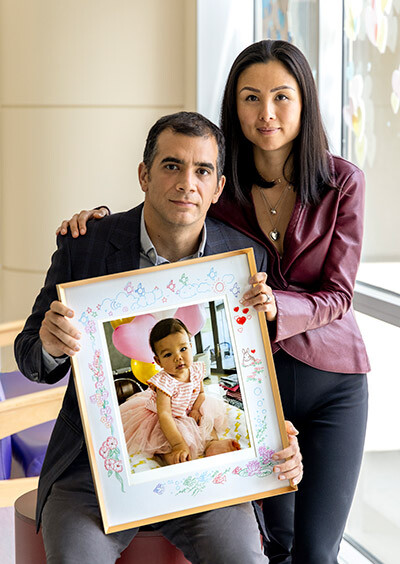The Sanford Family
Ethan and Nina named their daughter Cecilia, but from the moment she was born, she was always Ceci.
The youngest of three girls, Ceci enjoyed watching the wild rabbits running around in the backyard, and her first word was “tutu,” Mandarin for bunny. She chimed in with her sisters during the family’s nightly music video-watching routine.
And on a normal afternoon in December 2022, five weeks after a tumor next to her lower spine was discovered, Ceci went down for a nap and never woke up.

Ethan Sanford, M.D., a pediatric anesthesiologist at Children’s Health, and Nina do not know much about why Ceci died or the tumor that was discovered a couple of months prior involving the nerves in her lower back.
“I must have spoken with 30 or more physicians across the country, from Boston to San Francisco. Everyone was so kind and generous with their time, but still stumped,” said Nina, M.D., Chief of Gastrointestinal Radiation Oncology Service at UT Southwestern Medical Center. “The local team at Children’s Health was incredible. After her biopsy, the lead pathologist invited us to the lab to review her slides together. The morning of her MRI, the anesthesiologist bought her a toy to play with in recovery. We are so grateful.”
Months earlier, the couple noticed progressive weakness in Ceci’s right leg. By her first birthday, she could not pull to stand or crawl.
An MRI at Children’s Health confirmed the tumor controlling her right leg function, but an eight-hour surgical biopsy yielded no answers. Her diagnosis was rare – so rare that no one could pinpoint the next step.
After Ceci’s tumor was initially found, Ethan started a donation page to fundraise for clinical research efforts at Children’s Health, seeking to help children and families like his searching for answers. To date, the page has amassed more than $90,000 in generous gifts toward clinical research, with additional donations directly sent to the hospital in Ceci’s honor.
Research at Children’s Health helps scientists better understand diseases, chronic conditions and injuries, and can lead to the development of new medicines, treatments or approaches to caring for patients.
Philanthropy fuels new areas of research not presently funded by external entities; supports important, life-saving studies that are nationally and locally underfunded; and provides pilot funding that helps researchers successfully apply for larger, future grants such as from the National Institutes of Health.
Each year, there are more than 1,200 active research studies at Children’s Health, with nearly 13,000 patients enrolled.
“There have been many advancements in medicine, but much is still unknown. Even for entities that are named and whose pathophysiology is understood, current treatments are inadequate and inaccessible to many,” Ethan said.
This spring, the couple established a $100,000 endowment named Ceci’s Fund for Clinical Research to distribute annual funds to support clinical research and honor their daughter. The endowment is supported by funds raised from the donation page, along with additional generous gifts, and the family plans to continue growing the endowment.
“When we first began fundraising, it was a coping mechanism to find meaning in something that felt meaningless,” Ethan said. “Now, it helps our friends, family and us remember her. There are so many things Ceci didn’t get to do, so finding a long-term way for her life to have an impact on other children was important.”
Endowed funds are critical gifts because they provide perpetual support for a program or research area close to a donor’s heart. Contributions made to establish endowments are invested to generate earnings and increase in value over time.
Life is short, beautiful, and cruel. I would not wish our experience on my worst enemy. But, what it has taught me is to live bravely and with intention. We hope for Ceci to positively impact the world, and this fund is one way she will be able to do that.
— Nina
Kids count on us. We count on you.
Give to support innovative research, lifesaving treatments and compassionate care.
Did you enjoy this story?
If you would like to receive an email when new stories like this one are posted to our website, please complete the form below. We won't share your information, and you can unsubscribe any time.

